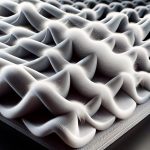I've always wondered if sleeping on satin sheets is as luxurious and harmless as it seems. Sure, the smooth texture feels nice against the skin, but I've heard rumors about the potential downsides, especially when it comes to satin made from synthetic materials. It's got me thinking about the chemicals and irritants that could be lurking in those shiny fabrics. I've decided to look into whether these concerns are valid and if they could really affect our health and sleep quality. Let's explore together what makes satin a questionable choice for some and how choosing the right type could make a difference.
Table of Contents
Key Takeaways
- Satin pillowcases can reduce hair tangling and maintain smooth hair, enhancing sleep quality.
- The gentle surface of satin reduces skin tugging and creasing, potentially preventing wrinkles.
- Satin's breathable nature helps create a cleaner sleep environment, reducing acne risks.
- Opting for OEKO-TEX certified satin ensures safety from harmful chemicals in bedding.
- Natural satin materials like silk offer hypoallergenic properties, making them a safer choice for sensitive skin.
Understanding Satin Materials
Satin isn't just any fabric; it's a special weave that gives clothes and bedding that smooth, shiny look we all love. Now, let's get something straight—satin is all about the weave, not the material. This means it can be made from a bunch of different stuff like silk, polyester, rayon, or nylon. The magic happens with its weave pattern, where you've got at least four weft threads chilling on top of a warp thread, and that's what gives satin that glossy surface that feels like a dream against the skin.
The real deal satin, the kind that makes you feel like royalty, needs long, continuous filaments. That's what's behind its legendary luster and softness. Whether it's your pajamas or your bedsheets, that luxurious appearance and feel? All thanks to satin. And get this, not all satin is created equal. You've got varieties like antique satin and slipper satin, each with its own vibe in terms of sheen and drape. So, when you're eyeing that satin piece, remember, it's a whole world of weave, materials, and textures that make it a standout.
Health Risks of Synthetic Fabrics
While we've been chatting about the silky-smooth feel of satin, it's important to note that not all that glitters is gold, especially when it comes to synthetic fabrics. Diving into the heart of synthetic satin, it's packed with chemicals like formaldehyde, Azo dyes, and even heavy metals. Yikes, right? These aren't just fancy science words; they're real culprits behind skin irritation, allergies, and, frankly, some scary health risks down the line.
Now, I'm not saying every satin pillowcase is out to get you, but sleeping on synthetic satin might mean cuddling up with toxins like organotin compounds and chlorobenzenes. Doesn't sound too cozy to me. So, what's a luxurious sleep-seeker to do? Well, swinging towards natural materials like cotton or silk could be a game-changer. These options cut down the risk of those unwanted bedtime guests – I'm talking about the chemical kind, of course.
And hey, if you're set on satin, no judgment here. Just keep an eye out for OEKO-TEX certified goodies. This certification means your satin dreams are safer, keeping those nasty chemicals at bay. Who knew the quest for perfect bedding could be so adventurous?
Benefits of Sleeping on Satin
Despite the concerns with synthetic materials, let's not overlook the perks of slipping into bed with satin sheets. I've found that the benefits of sleeping on satin are hard to ignore, especially when you're after that beauty sleep glow. For starters, satin pillowcases are a game-changer for keeping my hair smooth and free from tangles. They reduce friction and static, meaning I wake up with hair that looks like I've just walked out of a salon, not a wind tunnel.
But it's not just about smooth hair; satin's got a lot to offer for maintaining healthy skin. The gentle, smooth surface of satin pillowcases means less tugging and creasing on my skin overnight. This is crucial for preventing wrinkles and keeping my skin looking hydrated. Plus, the breathable nature of satin helps create a cleaner sleep environment, reducing dust and bacteria buildup. This is a big deal for anyone like me who's fighting the good fight against acne. Sleeping on satin reduces skin irritation and inflammation, which can really help in keeping my complexion clear. So yeah, making the switch to satin? Best decision for my skin and hair, hands down.
Choosing Safe Satin Bedding
When shopping for satin bedding, it's crucial to prioritize safety by looking for third-party certifications like OEKO-TEX Standard 100. This certification means you're getting safe options free from harmful chemicals often found in textiles. I always make it a point to dig into the material information, ensuring I avoid anything treated with toxic substances like formaldehyde or Azo dyes. It's not just about avoiding the bad stuff; it's about finding satin that gives you that luxurious feel without compromising your health.
I've learned that not all satin is created equal. Some are synthetic, loaded with chemicals, while others, like silk, offer a natural alternative with hypoallergenic properties. This distinction is crucial for me, as it affects not only my skin's health but also my overall wellbeing. Silk, as a satin alternative, has been a game-changer, providing both the elegance and the peace of mind I need.
In my quest for the perfect satin bedding, I've become quite the advocate for choosing products that are as close to natural as possible. It's about more than just aesthetics; it's about making a healthier choice for myself.
Satin Vs. Natural Alternatives
Often, I find myself weighing the benefits of silk against satin for my bedtime routine, especially considering silk's natural and hypoallergenic qualities. I mean, who doesn't want to dive into bed feeling like they're wrapped in a hug that's also kind to their skin? Silk, being free from the harsh chemicals often found in satin, has become my go-to. It's gentle on my skin, and I've noticed fewer irritations since making the switch.
What's more, silk's ability to regulate body temperature is a game-changer. I'm talking staying cool in the summer and cozy in the winter, without waking up feeling like I've just gone through a mini sauna session. And let's not forget the eco-friendly brownie points. Silk's production process, from its eco-friendly dyeing methods to being a biodegradable protein fiber, aligns with my sustainable living goals. Plus, it's cruelty-free, which makes me feel good about where my money's going.
Lastly, the luxurious feel of silk isn't just a myth. It's real, and it beats satin's synthetic feel any day. The natural sheen and durability of silk have turned my bed into a luxurious retreat. It's clear, when it comes to satin vs. natural alternatives like silk, silk takes the crown for being kinder to both the planet and my sleep.
Frequently Asked Questions
Is It OK to Sleep on Satin?
I've found it's totally okay to sleep on satin. It's actually great for my hair and skin, keeps me cool, and feels luxurious. Plus, it's hygienic. Overall, it's a win for my sleep routine.
What Are the Disadvantages of Satin Bedding?
I've found satin bedding's main downsides are its cool feel in winter, tricky cleaning requirements, higher cost, and ease of snagging. It also doesn't feel as breathable, making it less comfy for some sleepers.
Is Satin Good for Bed?
I've found satin really beneficial for bed because it reduces friction, keeping my skin and hair smooth. It's also breathable, helping me stay cool and reducing bacteria. Definitely improves my sleep quality and skin health.
Should I Sleep in Satin or Cotton?
I'd definitely choose satin over cotton for sleeping. It's smoother, keeps my hair and skin healthier by reducing friction and doesn't suck away moisture. For me, it's a no-brainer for better sleep quality.
- How Does Ring Spun Cotton Affect Garment Fit and Shape Retention? - August 13, 2024
- What Are the Challenges in Producing Ring Spun Cotton? - August 13, 2024
- Is Ring Spun Cotton Suitable for Plus-Size Clothing? - August 13, 2024




